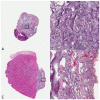Adrenocortical cell transplantation reverses a murine model of adrenal failure
- PMID: 21683224
- PMCID: PMC3118992
- DOI: 10.1016/j.jpedsurg.2011.03.057
Adrenocortical cell transplantation reverses a murine model of adrenal failure
Abstract
Purpose: Although adrenal insufficiency can be managed with steroid replacement, transplantation of adrenocortical cells may represent a more definitive therapy.
Methods: An adrenal failure model was created by adding stress to mice that underwent staged bilateral adrenalectomy. Murine adrenocortical cells were seeded onto collagen sponges. The grafts were implanted under the renal capsule during the first adrenalectomy. Some mice had an additional graft placed next to the kidney. A contralateral adrenalectomy and a laparotomy were performed 1 week after the first adrenalectomy. Two weeks later, blood was collected for corticosterone measurement; and implants were retrieved for adrenal-specific messenger RNA analysis and histology. Mice that underwent the same procedures but received a graft without cells served as controls.
Results: Control group mortality was 100%. Mice that had only one cell-seeded implant had 42% survival, whereas mice that had 2 cell-seeded implants had 100% survival. Retrieved implants demonstrated viable cells and expression of adrenocortical genes. The plasma corticosterone concentration in animals that survived was similar to that in normal mice.
Conclusion: Cells transplantation restored the adrenocortical function in these mice. Further optimization of this technique could bring a curative therapy to patients with adrenal insufficiency.
Copyright © 2011 Elsevier Inc. All rights reserved.
Figures



Similar articles
-
Transplantation of H-2Kb-transgenic adrenocortical cells in the mouse having undergone an adrenalectomy: functional and morphological aspects.Transplantation. 2000 Apr 27;69(8):1561-6. doi: 10.1097/00007890-200004270-00007. Transplantation. 2000. PMID: 10836362
-
Adrenal cortex transplantation after bilateral total adrenalectomy in the rat.Henry Ford Hosp Med J. 1989;37(3-4):154-6. Henry Ford Hosp Med J. 1989. PMID: 2576952
-
Differentiated corticosteroid production and regeneration after selective transplantation of cultured and noncultured adrenocortical cells in the adrenalectomized rat.Transplantation. 2000 Sep 15;70(5):836-43. doi: 10.1097/00007890-200009150-00022. Transplantation. 2000. PMID: 11003367
-
[Function-preserving adrenalectomy for adrenal tumors].Chirurg. 2012 Jun;83(6):519-27. doi: 10.1007/s00104-011-2192-7. Chirurg. 2012. PMID: 22580725 Review. German.
-
Adrenocortical endocrine disruption.J Steroid Biochem Mol Biol. 2016 Jan;155(Pt B):199-206. doi: 10.1016/j.jsbmb.2014.10.009. Epub 2014 Oct 18. J Steroid Biochem Mol Biol. 2016. PMID: 25460300 Review.
Cited by
-
Label-free enrichment of adrenal cortical progenitor cells using inertial microfluidics.PLoS One. 2012;7(10):e46550. doi: 10.1371/journal.pone.0046550. Epub 2012 Oct 4. PLoS One. 2012. PMID: 23056341 Free PMC article.
-
[Gene and cell therapy of adrenal pathology: achievements and prospects].Probl Endokrinol (Mosk). 2021 Dec 2;67(6):80-89. doi: 10.14341/probl12818. Probl Endokrinol (Mosk). 2021. PMID: 35018764 Free PMC article. Review. Russian.
-
New directions for the treatment of adrenal insufficiency.Front Endocrinol (Lausanne). 2015 May 6;6:70. doi: 10.3389/fendo.2015.00070. eCollection 2015. Front Endocrinol (Lausanne). 2015. PMID: 25999916 Free PMC article. Review.
-
Adrenocortical stem cells in health and disease.Nat Rev Endocrinol. 2025 Aug;21(8):464-481. doi: 10.1038/s41574-025-01091-2. Epub 2025 Mar 10. Nat Rev Endocrinol. 2025. PMID: 40065108 Review.
References
-
- Arlt W, Allolio B. Adrenal insufficiency. Lancet. 2003 May 31;361(9372):1881–1893. - PubMed
-
- Oelkers W. Adrenal insufficiency. N Engl J Med. 1996 Oct 17;335(16):1206–1212. - PubMed
-
- Oelkers W, Diederich S, Bahr V. Therapeutic strategies in adrenal insufficiency. Ann Endocrinol (Paris) 2001 Apr;62(2):212–216. - PubMed
-
- Witt CL. Adrenal insufficiency in the term and preterm neonate. Neonatal Netw. 1999 Aug;18(5):21–28. - PubMed
-
- Dunn JC, Chu Y, Lam MM, Wu BM, Atkinson JB, McCabe ER. Adrenal cortical cell transplantation. J Pediatr Surg. 2004 Dec;39(12):1856–1858. - PubMed
Publication types
MeSH terms
Substances
Grants and funding
LinkOut - more resources
Full Text Sources

